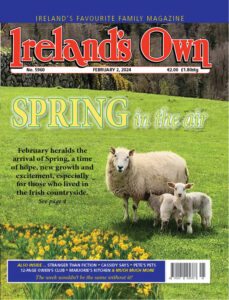St. Brigid’s Day – EUGENE DALY continues his series on various aspects of Irish folklore and customs
February 1st is considered the first day of spring and certainly the beginning of the farming year. This may seem a little off, as there are few outward signs of what we usually think of as spring. Few flowers are as yet peeping through the hard earth, save for the snowdrop and, a little later, the humble dandelion–both sacred to St. Brigid.
In ancient times February 1st was known as Imbolc (or Imbolg), one of the four great festivals of the Celts. The word Imbolc is thought to be derived from an old Gaelic word meaning ‘ewe’s milk’. At this time of year, the sheep’s milk begins to flow in preparation for lambing. At this time of year, also, the cows are beginning to calf and the cows begin to give their milk.
Brigit was the goddess of spring, a bright maiden bringing light and the beginning of new growth, taking over from the Cailleach, the hag of dark winter time. The fertility of the land is reawakened and preparations for spring sowing begin. Brigit was one face of the original mother goddess, the sun, the earth and all creation.
 Scholars hold that in her persona we find both the pagan goddess Brigit (or Brigid) who was once widely worshipped, not alone in Ireland but among the Continental Celts and the Christian saint, Brigid of Kildare. She was the patron of poets and also of healing and smith craft. She was a fire goddess and fed the fires of inspiration and the fire that changes metal as done by blacksmiths and other smiths.
Scholars hold that in her persona we find both the pagan goddess Brigit (or Brigid) who was once widely worshipped, not alone in Ireland but among the Continental Celts and the Christian saint, Brigid of Kildare. She was the patron of poets and also of healing and smith craft. She was a fire goddess and fed the fires of inspiration and the fire that changes metal as done by blacksmiths and other smiths.
In the medieval book ‘Lives of the Saints’ we read that Brigid, the Christian saint, was the daughter of a slave girl and a wealthy chieftain and that she was fostered by a druid. When she was young she gave her father’s sword to a poor man, who was begging for help. This shows her generosity, a trait she never lost.
She was beautiful, gifted and strong-minded enough to oppose her father when he attempted to marry her off to an eligible suitor. Instead she went her own way and founded a monastery located in Kildare (Cill Dara, the church of the oak).
Continue reading in this week’s Ireland’s Own


